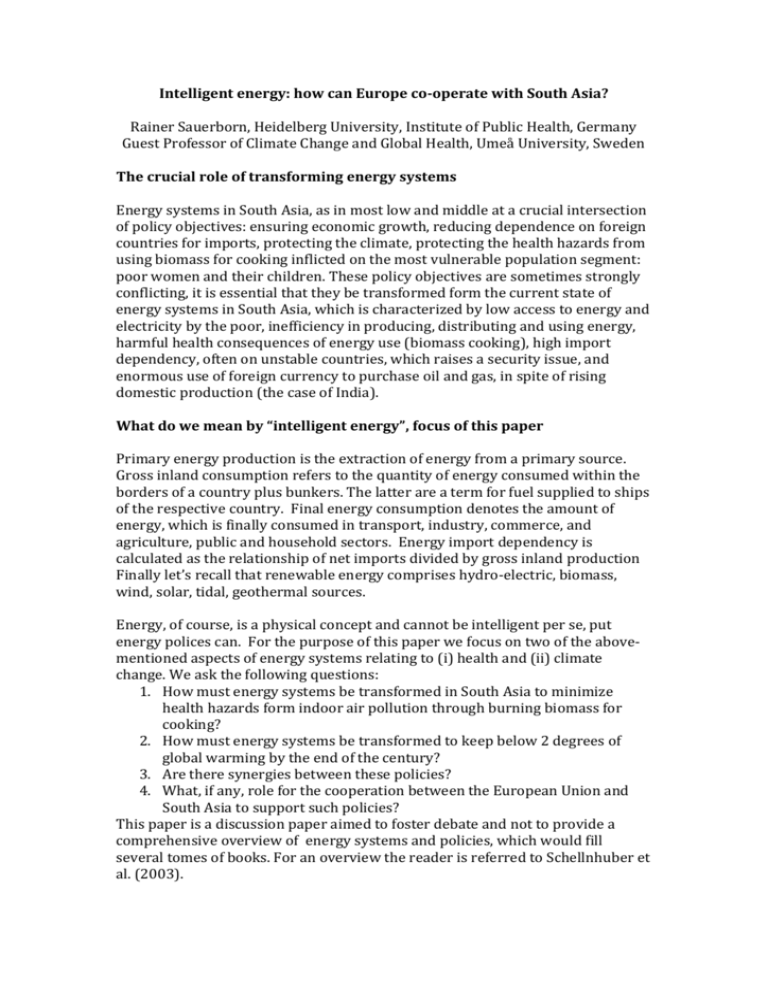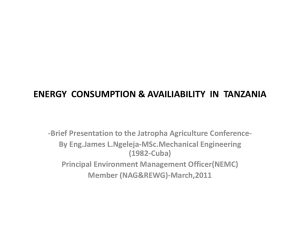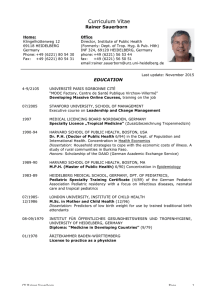Intelligent energy: how can Europe co
advertisement

Intelligent energy: how can Europe co-operate with South Asia? Rainer Sauerborn, Heidelberg University, Institute of Public Health, Germany Guest Professor of Climate Change and Global Health, Umeå University, Sweden The crucial role of transforming energy systems Energy systems in South Asia, as in most low and middle at a crucial intersection of policy objectives: ensuring economic growth, reducing dependence on foreign countries for imports, protecting the climate, protecting the health hazards from using biomass for cooking inflicted on the most vulnerable population segment: poor women and their children. These policy objectives are sometimes strongly conflicting, it is essential that they be transformed form the current state of energy systems in South Asia, which is characterized by low access to energy and electricity by the poor, inefficiency in producing, distributing and using energy, harmful health consequences of energy use (biomass cooking), high import dependency, often on unstable countries, which raises a security issue, and enormous use of foreign currency to purchase oil and gas, in spite of rising domestic production (the case of India). What do we mean by “intelligent energy”, focus of this paper Primary energy production is the extraction of energy from a primary source. Gross inland consumption refers to the quantity of energy consumed within the borders of a country plus bunkers. The latter are a term for fuel supplied to ships of the respective country. Final energy consumption denotes the amount of energy, which is finally consumed in transport, industry, commerce, and agriculture, public and household sectors. Energy import dependency is calculated as the relationship of net imports divided by gross inland production Finally let’s recall that renewable energy comprises hydro-electric, biomass, wind, solar, tidal, geothermal sources. Energy, of course, is a physical concept and cannot be intelligent per se, put energy polices can. For the purpose of this paper we focus on two of the abovementioned aspects of energy systems relating to (i) health and (ii) climate change. We ask the following questions: 1. How must energy systems be transformed in South Asia to minimize health hazards form indoor air pollution through burning biomass for cooking? 2. How must energy systems be transformed to keep below 2 degrees of global warming by the end of the century? 3. Are there synergies between these policies? 4. What, if any, role for the cooperation between the European Union and South Asia to support such policies? This paper is a discussion paper aimed to foster debate and not to provide a comprehensive overview of energy systems and policies, which would fill several tomes of books. For an overview the reader is referred to Schellnhuber et al. (2003). A sketch of the energy situation As in all emerging economies, the energy consumption has increased considerably in South Asia in the past 2 decades. In India for example, final energy use was 4.000 PJ in 2005 and is projected to rise to 11,000 PJ in 2020 go from, an overall increase of more than 150%. This is a a reflection of one the one hand population growth and on the other hand the growth of GDP/capita. In India, total gross domestic product (GDP) rose form about 2000 billion USD (PPP adjusted) in 1990 to 3,500 USD in 2006m. During this period, the primary energy supply increased from 10 EJ to 18 EJ. Interestingly, biomass contributed more energy than coal and gas, exceeded only by oil. Electricity amounted to about half of primary energy supply in 2006. In 2009 India’s energy consumption was covered about half by coal (47%), oil about a fourth (24%), renewable energies, mainly firewood by another 24%, natural gas by 7%) and nuclear covered only 1% (International Energy Agency (2010)). The bulk of energy imports are oil and gas. The main sources of oil comprise the Middle East (34%), Africa (27%), Saudi Arabia (18%) and Iran (11%). Hence 2/3 of oil imports are from South West Asia, which is currently again witnessing strive and conflict in Syria and Iran raising the specter of open war. Domestic primary energy production of fossil fuel ahs risen considerably in the past decade, but has not been able to catch up with increases in consumption. While the oil production has remained flat at below 1 million barrels per day, consumption has risen from 2,2 million barrels in 2000 to over 3 million in 2010. The production of natural gas shows essentially the same pattern. Both consumption and production have been steeply rising, but the curves are parallel leaving a gap of about 500 billion cubic feet (US Energy information administrations, International energy statistics, 2011). As for the final energy use by sectors residential (39%) use is in the same magnitude as industrial use (35%), whereas transport, which is the focus of media and public debate contributes only 16% of final energy use. Agriculture takes 6% and services 6%. Within the industry sector, projected growth is the largest: form 4200 PJ in 2005 to 10,200 PJ in 2020. The main industrial uses of energy remain roughly in the same proportion, with iron and steel leading the list followed by cement, aluminum and ammonia production ( ). About half of the energy used by industry comes from coal, followed by oil, electricity and gas. These proportions remain unchanged in the projections to 2020. Poverty and energy, energy poverty Poor people in India (like the rest of South Asia) suffer from lack of access to modern energy services, such as electricity or LPG. Rural electrification in India, although much progress has been achieved still leaves 25-50% of the population without access to electricity. This is known to be a crucial road block to development (information access of households, refrigeration, lighting of schools and homes, substitution of women’s chores, replacement of biomass as main fuel). Figure 1. Relationship between rural electrification and biomass use in South Asia. Source: van Duuren et al. (2012). The second feature of energy poverty in all LMICs is the reliance of households on solid fuel, largely biomass for cooking (and in some areas for heating). This has enormous adverse health effects, raising the risk of broncho-pulmonary disease, tuberculosis, cataract leading often to blindness, asthma, low birth weight (through CO formation), COPD and more. Indoor air pollutions causes more deaths and more disease burden in South Asia than out door air pollution or malaria. It amounts to 6% of the total disease burden in India (WGBU 2003) .The public awareness is the inverse: outdoor air pollution is on the top of media attention. Indoor air pollution is therefore often dubbed the “silent killer” affecting the most vulnerable segment of the population: mothers and their small children. Adverse health effects of climate change In the context of this paper, I can only sketch the conundrum of energy, climate and health. Climate change, of course, is caused by the massive and increasing use of fossil fuels since the industrial revolution at the end of the 18th century. Importantly low income regions such as South Asia, land use changes from deforestation, intensive agriculture and livestock contribute about 25% to global warming through the combined effects of methane, NOx and CO2. The thorny policy issues at the global negotiation table (UNFCC, COPs) revolves around the principles of shared but differentiated responsibility, precautionary action and no regrets strategies: Shared but differentiated responsibilities The agreed principle implies that all countries, irrespective of their level and timing of industrialization share the responsibility to contribute to effective climate policy limiting global warming to 2 degrees C till the end of the century, a level considered as acceptable, if certainly not completely safe. Differentiated means that the types of action (reducing deforestation in some countries, switching from coal to gas in others, energy efficiency world wide etc.) and the source of payments (the rich industrialized countries are called upon to shoulder the loin share of the burden of mitigation policies. Central to mitigation is the transformation of energy systems. Another ramification of interest in the framework of this paper is the enormous toll in deaths and diseases that South Asia is faced with in the process of climate change: lower harvest yields due to a mixture of warming, drought, flooding, salination of coastal soils, extreme weather events (SREX 2012) wreaking economic havoc and malnutrition. A rise in diarrheal diseases and vector borne infectious diseases, mainly Dengue; an increase in within country and cross border migration flows with the concomitant disruption of social networks and precarious health conditions. These are the health effect of a mismanagement of global energy systems. The only fair path to climate policy respecting the principle of shared, but differentiated responsibility is called “contraction and convergence”, the interested reader is referred to (IPCC) 2007 Policy conclusions: While the policy implications of the energy landscape I sketched are far reaching and cannot be discussed in such a limited space, the focus of this paper was on the energy policy goals of maintaining security/energy independence, protecting health and contributing South Asia’s fair share to limit global warming to 2°C by 2010. What would access to electricity for all households cost in South Asia? What would the health co-benefits (from avoided deaths and disease) amount to? Table 1. Compares the data answering these questions between South Aisa, Sub-Saharan Africa and Pacific Asia (van Duuren et al. 2012, Table 1). It would cost between 160 and 180 million US$ to achieve access to electricity for all in South Asia, 55-60million to phase out traditional biomass for cooking. The health benefit of both policies would be enormous, saving 800,000 deaths and an untold amount of disease. Table 1. Costs and health benefits of policies to achieve (i) universal access to electric energy (ii) removal of traditional hazardous biomass. (Van Duuren et al. 2012) Figure 2 shows the costs of policies focusing on energy security only (left), focusing on avoiding indoor air pollution (second from left), avoiding climate change (second column from right) and all policies combined. It clearly demonstrates that a single sectoral lens seriously overestimates the marginal costs of policies and ignores synergies (van Duuren , 2012) – a call for hugely increased inter-sectoral cooperation including scientists and policy experts form the energy, health, security, climate sectors. Figure 2. Costs of policies focusing on energy security only (left), focusing on avoiding indoor air pollution (second from left), avoinding climate change (second column from right) and all policies combined (Van Duuren et al. 2012) Opportunities for cooperation with the EU Outline of the EU’s roadmap for transforming energy systems In its policy road mal for 2020 (EU 2012), the EU set the triple goals of (i) reducing greenhouse gas emission by 20% (with 1990 as the reference year) (ii) increasing the proportion of modern renewables to 20% (iii) increasing energy efficiency by 20% This implies a radical overhaul of energy production (and distribution for that matter). By the end of the century the largest proportion of reduction of greenhouse gases in Europe will have to come from technical energy efficiency gains and from changes in behavior and low-energy living, working and transport systems. Of the remaining energy requirements renewables, mainly solar-thermal, wind and photovoltaic (PV) will contribute more than 50%Coal will be essentially phased out by the middle of the century, while oil will be phased out by 2075. A hotly debated issue is whether carbon capture and storage from plants burning fossils or modern biomass can prolong the “life” of these fuels. Even under this scenario, fossils will be nearly completely phased out in 2100. Potential cooperation South Asia - Europe (i) Joint research Europe is leading in energy efficiency engineering and in renewable technology. Hence, a cooperation funded by EU research funding seems to be the most immediate consequence. Unfortunately the research funding worldwide is inversely related to policy needs. In 2008 40% of energy research was still directed to nuclear technology, while energy efficiency received only 12% and modern renewables only 10% of the share respectively (Smith et al. 2012). (ii) Joint policy solution Joint South-Asian – European teams of energy policy-making teams including scientists from climate and public health could look at the large array of pricing, regulation, legislation and technology assessment. The latter should include health impact assessment. (iii) Economic cooperation. The most immediate pathway building on a large array of existing contracts between industry and the public sector on both sides of the South-Asian – European partnership. (iv) Joint trans-disciplinary and trans-sector training programs These would usefully be targeted to enlist young scientific minds into the extremely difficult approach to energy related research addressing health, climate, economic, agriculture and business sectors. Similarly flagship courses for executives/policy-makers should be set up jointly to expose decision-makers to the complex evidence and to compare different policy solutions and their effects and costs in the two regions. References: Böhringer C, Welsch (2004) Contraction and convergence of carbon emissions: an inter-temporal multi-region CGE analysis. Journal of Policy Modeling 26(1): 21-39. European Commission (2012) Market observatory for energy-key figures. Directorate-General for Energy, EC, Brussels. June 2011. Global Energy Assessment-toward a sustainable future (2012) Key findings, summary for policy makers, technical summary. Cambridge University Presss, Cambridge,UK and IIASA, Laxenburg. Intelligent Energy Europe (2012) Intelligent Energy-Europe II:Performance Report 2007-2011. Competitiveness and Innovation Program 2007-2011. European Commission, Brussels. Global Trade Atlas http://www.worldtradestatistics.com/English/GTIS.html accessed on October 7, 2012. Grassl H, Schubert R, Epiney A, Kulessa M, Luther J, Nuscheler F, Sauerborn R, Schellnhuber HJ, Schulze E (2005) Fighting poverty through environmental policy. German Advisory Council for Global Change (WBGU, Berlin), Earthscan. London and Sterling. Grassl H, Schubert R, Epiney A, Kulessa M, Luther J, Nuscheler F, Sauerborn R, Schellnhuber HJ, Schulze E (2003) Trasnforming energy systems. German Advisory Council for Global Change (WBGU, Berlin), Earthscan. London and Sterling. Mukhopadhyay R et al. (2012) Cooking practices, air quality, and acceptability of advanced cookstoves in Haryana, India: an exploratory study to inform large-scale interventions. Global Health Action 5:19016, http://dx.doi.org/10.3402/gha.v50.19016. Nilsson M, Evengård B, Sauerborn R, Byass P (2012) Connecting the global climate change and public health agendas. PLoS-1 (accepted). Riahl K, dentener F, Gielen D, Grubler A, Jewell J, Klimont Z,Krey V, McCollum D, Pachauri S, Rao S et al. (2012) Energy pathways for sustainable development . The Global Energy Assessment: Towards a more sustainable future. GEA: Cambridge University Presss, Cambridge,UK and IIASA, Laxenburg. Sauerborn R (2010) A changing climate’s health impact: Sensitizing researchers and policy-makers to a huge and neglected issue. EU Public Service Review in science and technology. Sauerborn R, Kjellstrom T, Nilsson M (2009) Health as a crucial driver for climate policy. Global Health Action, DOI: 10.3402/gha.v2i0.2104. Smith KR, Haigler E (2008) Co-benefits of climate mitigation and health protection in energy systems: socping methods. Annual Review of Public Health 29:11-25. Smith KR (2003) Indoor air pollution and acute respiratory infections. Indian Pediatrics 40:815-819Van Duuren DP, Nakicenovic N, Riahi K, BrewHammond A, Kammen D, Modi V, Nilsson M, Smith KR (2012) An energy vision: the transformation towards sustainability–interconnected challenges and solutions. Current opinions in Envt’l Sustainability 4:18-34. US Energy information administrations, International energy statistics (2011)










